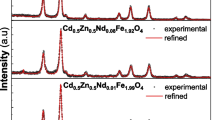Abstract
We report data on the composition and crystal structure of the first As3+-bearing natural argyrodite, spryite. Spryite has the formula \(({{\text{Ag}}_{7.98} {\text{Cu}}_{0.05}})_{\varSigma = 8.03} ({{\text{As}}_{0.31}^{5 +} {\text{Ge}}_{0.36} {\text{As}}_{0.31}^{3 +} {\text{Fe}}_{0.02}^{3 +}})_{\varSigma = 1.00} {\text{S}}_{5.97}\), ideally \({\text{Ag}}_{8} ({{\text{As}}_{0.5}^{3 +} {\text{As}}_{0.5}^{5 +}}){\text{S}}_{6}\). The crystal studied was found in a sample from the Uchucchacua polymetallic deposit, Oyon district, Cajatambo, Lima Department, Peru. The structure was refined in the space group Pna21 up to R = 0.0782 using 2099 observed reflections [2σ(I) level]. Spryite is intimately twinned with six twin domains. The structure solution showed that As3+ and As5+ coexist in the new mineral, which represents the first case ever discovered in either a mineral or a synthetic compound belonging to a sulfide/sulfosalt group. High-temperature in situ X-ray diffraction experiments indicated that no phase transitions occur in the temperature range investigated and that the mineral does not show any evidence of fast ionic conduction.




Similar content being viewed by others
References
Belin R, Zerouale A, Pradel A, Ribes M (2001) Ion dynamics in the argyrodite compound Ag7GeSe5I: non-Arrhenius behavior and complete conductivity spectra. Solid State Ion 143:445–455
Bindi L, Evain M (2007) Gram-Charlier development of the atomic displacement factors into mineral structures: the case of samsonite, Ag4MnSb2S6. Am Miner 92:886–891
Bindi L, Downs RT, Menchetti S (2010) The crystal structure of billingsleyite, Ag7(As, Sb)S6, a sulfosalt containing As5+. Can Miner 48:155–162
Bindi L, Nestola F, Guastoni A, Zorzi F, Peruzzo L, Raber T (2012) Te-rich canfieldite, Ag8Sn(S, Te)6, from Lengenbach quarry, Binntal, Canton Valais, Switzerland: occurrence, description and crystal structure. Can Miner 50:111–118
Brese NE, O’Keeffe M (1991) Bond-valence parameters for solids. Acta Crystallogr B47:192–197
Chen HM, Maohua C, Adams S (2015) Stability and ionic mobility in argyrodite-related lithium-ion solid electrolytes. Phys Chem Chem Phys 17:16494–16506
Eulenberger G (1977) Die Kristallstrukture der Tieftemperaturmodifikation von Ag8GeS6. Monat Chem 108:901–913
Evain M, Gaudin E, Boucher F, Petříček V, Taule-lle F (1998) Structures and phase transitions of the A7PSe6 (A = Ag, Cu) argyrodite-type ionic conductors. I. Ag7PSe6. Acta Crystallogr B 54:376–383
Frank D, Gerke B, Eul M, Pöttgen R, Pfitzner A (2013) Synthesis and crystal structure determination of Ag9FeS4.1Te1.9, the first example of an iron containing argyrodite. Chem Mater 25:2339–2345
Gaudin E, Boucher F, Evain M (2001) Some factors governing Ag+ and Cu+ low coordination in chalcogenide environments. J Solid State Chem 160:212–221
Gu X-P, Watanabe M, Hoshino K, Shibata Y (2003) New find of silver tellurosulphides from the Funan gold deposit, East Shandong, China. Eur J Miner 15:147–155
Gu X-P, Watanabe M, Xie X, Peng S, Nakamuta Y, Ohkawa M, Hoshino K, Ohsumi K, Shibata Y (2008) Chenguodaite (Ag9FeTe2S4): a new tellurosulfide mineral from the gold district of East Shandong Peninsula, China. Chin Sci Bull 53:3567–3573
Kraus W, Nolze G (1996) PowderCell—a program for the representation and manipulation of crystal structures and calculation of the resulting X-ray powder patterns. J Appl Crystallogr 29:301–303
Kuhs WF, Nitsche R, Scheunemann K (1979) The argyrodites—a new family of tetrahedrally close-packed structures. Mater Res Bull 14:241–248
Oudin E, Picot P, Pillard F, Moëlo Y, Burke E, Zakrzewski A (1982) La benavidesite, Pb4(Mn, Fe)Sb6S14, un nouveau mineral de la serie de la jamesonite. Bull Minér 105:166–169
Oxford Diffraction (2006) CrysAlis RED (Version 1.171.31.2) and ABSPACK in CrysAlis RED. Oxford Diffraction Ltd, Abingdon
Paar WH, Roberts AC, Berlepsch P, Armbruster T, Topa D, Zagler G (2004) Putzite, (Cu4.7Ag3.3)8GeS6, a new mineral species from Capillitas, Catamarca, Argentina: description and crystal structure. Can Miner 42:1757–1769
Petříček V, Dušek M, Palatinus L (2006) JANA2006, a crystallographic computing system. Institute of Physics, Academy of Sciences of the Czech Republic, Prague
Putz H (2005) Mineralogy and genesis of epithermal ore deposits at Capillitas, Catamarca Province, NW Argentina. Ph.D. thesis, Salzburg Univ., Salzburg
Putz H, Paar WH, Sureda RJ, Roberts AC (2002) Germanium mineralization at Capillitas, Catamarca Province, Argentina. International Mineralogical Association, 18th General Meeting (Edinburgh), Abstract, 265
Rao RP, Adams S (2011) Studies of lithium argyrodite solid electrolytes for all-solid-state batteries. Phys Status Solidi A 208:1804–1807
Shannon RD (1976) Revised effective ionic radii and systematic studies of interatomic distances in halides and chalcogenides. Acta Crystallogr A 32:751–767
Wang N (1978) New data for Ag8SnS6 (canfieldite) and Ag8GeS6 (argyrodite). N Jahrb Miner Monat 1978:269–272
Weisbach A (1886) Argyrodit, ein neues Silbererz. N Jahrb Geol Paläont 2:67–71
Winkler C (1886) Germanium, Ge, a new nonmetallic element. Berichte der Deutschen Chem Gesell 19:210–211
Zucker UH, Schulz HH (1982) Statistical approaches for the treatment of anharmonic motion in crystals. II. Anharmonic thermal vibrations and effective atomic potentials in the fast ionic conductor lithium nitride (Li3N). Acta Crystallogr A 38:568–576
Acknowledgments
The paper benefited by the official reviews made by Frantisek Laufek and Christopher Stanley. The research was supported by “progetto d’Ateneo 2013, University of Firenze” to L.B.
Author information
Authors and Affiliations
Corresponding author
Rights and permissions
About this article
Cite this article
Bindi, L., Keutsch, F.N., Morana, M. et al. Spryite, \({\text{Ag}}_{8}\left({{\text{As}}_{0.5}^{3 +} {\text{As}}_{0.5}^{5 +}}\right){\text{S}}_{6}\): structure determination and inferred absence of superionic conduction of the first As3+-bearing argyrodite. Phys Chem Minerals 44, 75–82 (2017). https://doi.org/10.1007/s00269-016-0838-1
Received:
Accepted:
Published:
Issue Date:
DOI: https://doi.org/10.1007/s00269-016-0838-1




